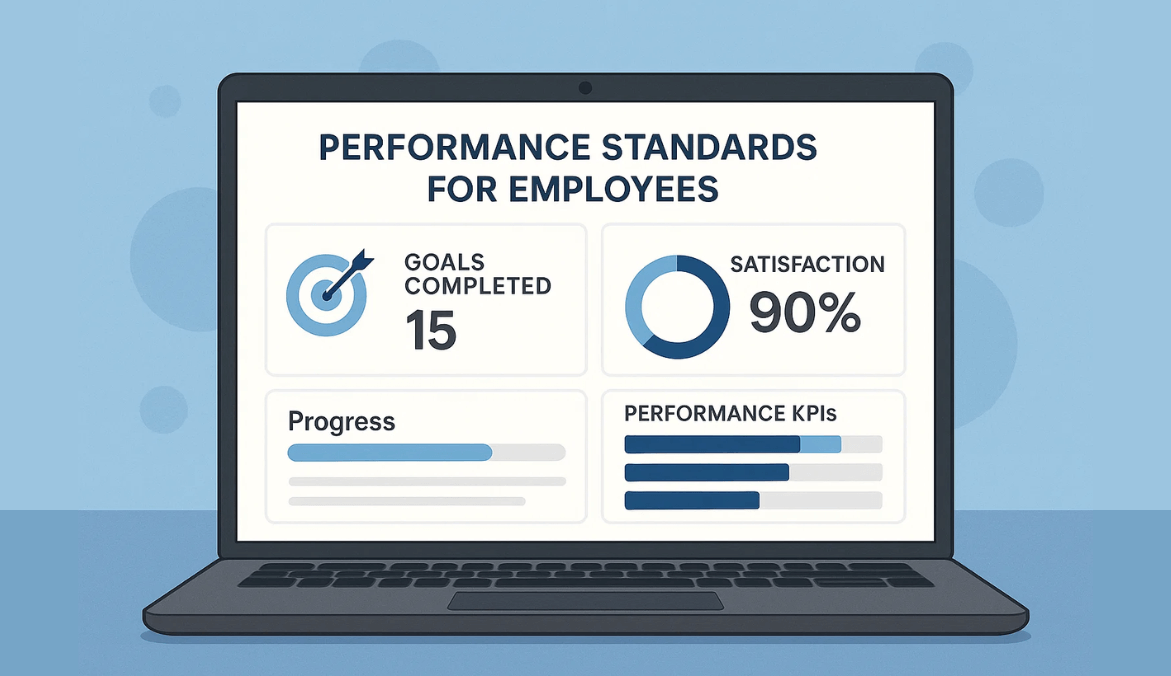Introduction
Let me start with a quick truth I’ve learned in my 15+ years of leading teams: most employees want to perform well. The problem isn’t motivation — it’s clarity. Too often, people work hard but still miss the mark because expectations were never spelled out clearly.
That’s where effective performance standards come in. Done right, they give employees a clear target, managers a fair way to evaluate, and organizations a reliable path to results. Done wrong (or skipped entirely), they create frustration, mistrust, and wasted effort.
In this guide, I’ll walk you step-by-step through how to set performance standards that actually work — not just theory, but practical methods I’ve used in real businesses.
Why Set Effective Performance Standards for Employees
Performance standards aren’t about micromanagement; they’re about clarity and fairness. Here’s why they matter:
- Alignment: Employees know exactly what success looks like.
- Motivation: Clear targets spark actual progress. For example, organizations that establish clear, measurable goals see about a 25% boost in productivity.
- Consistency: Evaluations feel objective, not personal.
Think of them as the rules of the game. Imagine playing football without knowing where the goalpost is — that’s what working without standards feels like.
Gallup found that employees are 3.6 times more likely to be engaged when they’re involved in setting their goals. That buy-in doesn’t just feel good, it drives results.
Step-by-Step Guide to Setting Effective Performance Standards
Step 1: Perform a Thorough Job Analysis
Before you can set expectations, you need to understand the job inside out. Break down the role into tasks, skills, and outcomes.
👉 Pro tip: Spend time shadowing or interviewing employees in that role. In one organization, I realized a customer service team was being judged on call volume, but the real impact came from resolution quality. That shift changed everything.
Step 2: Define SMART Standards
Vague goals like “do better” are useless. Use the SMART framework: Specific, Measurable, Achievable, Relevant, and Time-bound.
For example, instead of “improve response time,” set:
“Resolve 80% of support tickets within 24 hours, maintaining 90% customer satisfaction.”
I once helped a sales team switch from “increase sales” to “achieve $500,000 in new deals per quarter with at least 20% from new clients.” Within two quarters, their confidence (and results) skyrocketed.
Step 3: Make Standards Realistic and Exceedable
Good standards stretch people without breaking them. Too easy? They’ll coast. Too hard? They’ll burn out.
👉 Pro tip: Start slightly below your aspirational target. Let people hit it, then adjust upward. That way, they experience success before scaling higher.
Step 4: Ensure Standards Are Within Employee Control
Nothing kills morale faster than being held responsible for things outside your control. If an employee can’t influence it, don’t make it a standard.
Example: Judging a recruiter on “time to hire” when approvals from senior management take weeks isn’t fair. Instead, measure what’s within their influence: number of qualified candidates sourced per week.
Step 5: Involve Employees in the Process
This is a step many leaders skip, and it’s a big mistake. Involving employees builds buy-in.
I once worked with a finance team where resistance to new standards was sky-high. We changed approach: instead of imposing targets, we asked them to co-create the measures. The shift was dramatic — when people helped define the goals, they owned them.
👉 Actionable tip: Try this script: “If you were evaluating your role, what would success look like?” You’ll be surprised at how practical and fair employees’ answers are.
Step 6: Tailor Metrics by Role
Not every role can or should be measured the same way. A marketer’s success isn’t measured like a support agent’s.
- Content Writer: “Publish 4 articles a month with at least 70% engagement score.”
- Support Rep: “Resolve 85% of tickets within 24 hours.”
- Admin Staff: “Process 95% of invoices error-free each week.”
👉 Pro tip: Avoid generic “productivity” metrics. They often overlook role-specific contributions.
Step 7: Communicate and Document Clearly
Don’t let performance standards live in your head. Document them in writing, keep them visible, and communicate them in simple, direct language.
I’ve seen standards written like legal contracts — and employees walked away more confused than before. Plain language always wins.
Step 8: Monitor Performance & Provide Ongoing Feedback
Standards aren’t “set and forget.” They need monitoring and continuous feedback.
👉 Pro tip: Use monthly check-ins instead of waiting for annual reviews. In my experience, waiting a year to correct course almost always ends in frustration — for both the manager and the employee.
Step 9: Recognize and Reward Success
Praise matters more than people realize. Employees who are regularly recognized are 45% less likely to leave. Plus, weekly recognition boosts engagement and belonging—a powerful retention tool.
Step 10: Review and Adjust Standards Periodically
Work changes, markets shift, and standards should evolve with them. What worked last year may not fit today.
👉 Actionable tip: Schedule a semi-annual review of all standards. Ask, “Does this still make sense?” If the answer is no, update it.
Real-World Examples
| Role | Example Standard | Insights from My Experience |
|---|---|---|
| Content Writer | Publish 4 articles/week with ≥70% engagement | Engagement proved more valuable than sheer output. |
| Support Rep | Resolve 80% of tickets within 24 hrs at 90% CSAT | Agents were more motivated when they co-created this metric. |
| Admin Staff | Complete 95% of data entries error-free weekly | Accuracy soared once clarity and fairness were built in. |
| Sales Executive | Achieve $500K in quarterly revenue with ≥20% from new clients | Clear, specific targets boosted both confidence and results. |
| Software Developer | Deliver 90% of sprint tasks on time with <5% bug rate in UAT | Quality + timeliness balance helped avoid burnout. |
| HR Recruiter | Shortlist 15 qualified candidates per month with ≥70% offer acceptance | Switching from “time-to-hire” to this metric made standards fairer. |
| Project Manager | Ensure 90% of projects close within scope, budget, and deadline | Framing standards around outcomes improved accountability. |
| Marketing Specialist | Generate 500 MQLs/month with ≥30% conversion to SQL | Clear marketing-sales alignment drove measurable impact. |
Turning Standards into Success: How Mera Monitor Helps
Setting performance standards is only half the battle — the real challenge is ensuring they’re met consistently and fairly. That’s where Mera Monitor bridges the gap between expectations and execution.
With its advanced monitoring and productivity features, managers gain clear visibility into how employees work, while employees benefit from fair, transparent evaluation. Here’s how it supports performance standards in practice:
- Automated Timesheets – No guesswork or manual edits. Mera Monitor captures logins, logouts, and breaks in real time, ensuring accurate records.
- Active vs. Idle Time Tracking – Distinguishes productive work from idle hours, making performance assessments more precise.
- Attendance + Activity Verification – Aligns clock-ins with actual activity across apps, websites, and screens, eliminating gaps between presence and performance.
- Task & Project-Level Insights – Connects hours logged with real deliverables, ensuring standards measure meaningful outcomes, not just time spent.
- Fraud Detection Signals – Flags suspicious patterns like rounded shifts, unusual overtime, or repeated edits — so managers can act early.
💡 Pro Insight: Standards lose power if they aren’t backed by visibility. With Mera Monitor, you don’t just set expectations — you ensure they’re achievable, measurable, and fair.
👉 Start a Free Trial or Book a Demo today and see how Mera Monitor turns performance standards into real business results.
Conclusion
If there’s one thing I’ve learned in 15+ years, it’s this: performance standards only work if they’re clear, fair, and flexible. Set them with employees, not against them. Keep them realistic, monitor them consistently, and don’t be afraid to adjust as the business evolves.
At the end of the day, effective standards aren’t about control — they’re about creating an environment where employees know what winning looks like and feel empowered to get there.
FAQs
The key is to make them quantifiable. Use the SMART framework—standards should be Specific, Measurable, Achievable, Relevant, and Time-bound. For example, instead of “improve customer service,” define it as “Resolve 85% of tickets within 24 hours while maintaining 90% CSAT scores.”
For managers: tie standards to outcomes you can track (numbers, percentages, deadlines).
For employees: communicate how measurement helps them know exactly what’s expected—and how their success will be recognized.
Strong performance standards are role-specific. They must reflect what success looks like in each function. A few examples:
Customer Support: Resolve 80% of queries within 24 hours at 90% satisfaction.
Sales Executive: Generate $500K in quarterly revenue with at least 20% from new clients.
Content Writer: Publish 4 articles/month with ≥70% engagement.
HR Recruiter: Shortlist 15 qualified candidates monthly with a 70% offer acceptance rate.
👉 For managers: avoid generic measures like “be productive.” They frustrate employees because they’re vague. Clear examples make evaluations transparent and fair.
At least twice a year—but in fast-moving industries (like tech or digital marketing), quarterly reviews are smarter. Business realities shift, and standards that felt relevant six months ago may now be outdated.
👉 For managers: treat reviews as conversations, not audits. Ask employees if the goals still make sense and whether they feel achievable.
👉 For employees: encourage them to share feedback during reviews—what’s working, what’s not—so the standards stay realistic and motivating.
Involvement builds buy-in and accountability. Employees are more likely to embrace standards they helped shape. Start by asking: “What does success look like in your role?” Then refine their input with measurable outcomes.
👉 For managers: co-creation prevents resistance and makes evaluations feel less “top-down.”
👉 For employees: involvement gives them ownership—turning performance standards into their goals, not just management’s.
Unrealistic goals do more harm than good—they demotivate, cause burnout, and break trust. If morale dips or results stall, take that as a red flag to recalibrate.
👉 For managers: review the data—are most employees consistently missing the mark despite genuine effort? If yes, adjust downward to something achievable.
👉 For employees: speak up if a target feels unachievable. Frame it constructively: “Here’s why this goal feels out of reach, and here’s an alternative that would still stretch me without setting me up for failure.”
 Gift Card ₹999
Gift Card ₹999

